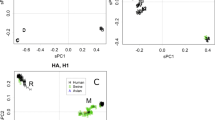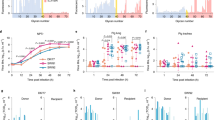Summary
The hemagglutinin (HA) genes of influenza type A (H1N1) viruses isolated from swine were cloned into plasmid vectors and their nucleotide sequences were determined. A phylogenetic tree for the HA genes of swine and human influenza viruses was constructed by the neighbor-joining method. It showed that the divergence between swine and human HA genes might have occurred around 1905. The estimated rates of synonymous (silent) substitutions for swine and human influenza viruses were almost the same. For both viruses, the rate of synonymous substitution was much higher than that of nonsynonymous (amino acid altering) substitution. It is the case even for only the antigenic sites of the HA. This feature is consistent with the neutral theory of molecular evolution. The rate of nonsynonymous substitution for human influenza viruses was three times the rate for swine influenza viruses. In particular, nonsynonymous substitutions at antigenic sites occurred less frequently in swine than in humans. The difference in the rate of nonsynonymous substitution between swine and human influenza viruses can be explained by the different degrees of functional constraint operating on the amino acid sequence of the HA in both hosts.
Similar content being viewed by others
References
Air GM, Gibbs AJ, Laver WG, Webster RG (1990) Evolutionary changes in influenza B are not primarily governed by antibody selection. Proc Natl Acad Sci USA 87:3884–3888
Both GW, Shi CH, Kilbourne ED (1983) Hemagglutinin of swine influenza virus: a single amino acid change pleiotropically affects viral antigenicity and replication. Proc Natl Acad Sci USA 80:6996–7000
Buonagurio DA, Nakada S, Parvin JD, Krystal M, Palese P, Fitch WM (1986) Evolution of human influenza A virus over 50 years: rapid, uniform rate of change in NS gene. Science 232:980–982
Caton A, Brownlee GG, Yewdell JW, Gerhard W (1982) The antigenic structure of influenza virus A/PR/8/34 hemagglutinin (H1 subtype). Cell 31:417–427
Concannon P, Cummings IW, Salser WA (1984) Nucleotide sequence of the influenza virus A/USSR/90/77 hemagglutinin gene. J Virol 49:276–278
Fang R, Jou WM, Huylebroeck D, Devos R, Fiers W (1981) Complete structure of A/duck/Ukraine/63 influenza hemagglutinin gene: animal virus as progenitor of human H3 Hong Kong 1986 influenza hemagglutinin. Cell 25:315–323
Feldmann H, Kretzschmar E, Klingeborn B, Rott R, Klenk H-D, Garten W (1988) The structure of serotype H10 hemagglutinin of influenza A virus: comparison of an apathogenic avian and a mammalian strain pathogenic for mink. Virology 165:428–437
Goldfield M, Bartley JD, Pizzuti W, Black HC, Altman R, Halperin WE (1977) Influenza in New Jersey in 1976: isolation of influenza A/New Jersey/76 virus at Fort Dix. J Infect Dis 136(suppl):S347-S355
Hayashida H, Toh H, Kikuno R, Miyata T (1985) Evolution of influenza virus genes. Mol Biol Evol 2:289–303
Jabbar MA, Sivasubramanian N, Nayak DP (1985) Influenza viral (A/WSN/33) hemagglutinin is expressed and glycosylated in the yeastSaccharomyces cerevisiae. Proc Natl Acad Sci USA 82:2019–2023
Hinshaw VS, Alexander DJ, Aymard M, Bachmann PA, Easterday BC, Hannoun C, Kida H, Lipkind M, MacKenzie JS, Nerome K, Schild GC, Scholtissek C, Senne DA, Shortridge KF, Skehel JJ, Webster RG (1984) Antigenic comparisons of swine-influenza-like H1N1 isolates from pigs, birds and humans: an international collaborative study. Bull WHO 62:871–878
Kendal AP, Noble GR, Dowdle WR (1977) Swine influenza viruses isolated in 1976 from man and pig contain two coexisting subpopulations with antigenically distinguishable hemagglutinins. Virology 82:111–121
Kida H, Kawaoka Y, Naeve CW, Webster RG (1987) Antigenic and genetic conservation of H3 influenza virus in wild ducks. Virology 159:109–119
Kida H, Shortridge KF, Webster RG (1988) Origin of the hemagglutinin gene of H3N2 influenza viruses from pigs in China. Virology 162:160–166
Kilbourne ED, Easterday BC, McGregor S (1988a) Evolution to predominance of swine influenza virus hemagglutinin mutants of predictable phenotype during single infections of the natural host. Proc Natl Acad Sci USA 85:8098–8101
Kilbourne ED, Taylor AH, Whitaker CW, Sahai RR, Caton AJ (1988b) Hemagglutinin polymorphism as the basis for low-and high-yield phenotypes of swine influenza virus. Proc Natl Acad Sci USA 85:7782–7785
Kimura M (1968) Evolutionary rate at the molecular level. Nature 217:624–626
Kimura M (1983) The neutral theory of molecular evolution. Cambridge University Press, Cambridge
Meier-Ewert H, Gibbs AJ, Dimmock NJ (1970) Studies on antigenic variations of haemagglutinin and neuraminidase of swine influenza virus isolates. J Gen Virol 6:409–419
Mizusawa S, Nishimura S, Seela F (1986) Improvement of the chain termination method of DNA sequencing by use of deoxy-7-deazaguanosine t triphosphate in place of dGTP. Nucleic Acids Res 14:1319–1324
Morbidity and Mortality Weekly Report (1988) Human infection with swine influenza virus—Wisconsin. In: Epidemiologic notes and reports, vol 37, p 661
Murphy BR, Webster RG (1985) Orthomyxoviruses. In: Fields BN (ed) Virology. Raven Press, New York, pp 1091–1152
Nakjima K, Desselberger D, Palese P (1978) Recent human influenza A (H1N1) viruses are closely related genetically to strains isolated in 1950. Nature 274:334–339
Nakajima K, Nobusawa E, Nakajima S (1984) Genetic relatedness between A/swine/Iowa/15/30(H1N1) and human influenza viruses. Virology 139:194–198
Nei M, Gojobori T (1986) Simple methods for estimating the numbers of synonymous and nonsynonymous nucleotide substitutions. Mol Biol Evol 3:418–426
Nerome K, Sakamoto S, Yano N, Yamamoto T, Kobayashi S, Webster RG, Oya A (1983) Antigenic characteristics and genome composition of a naturally occurring recombinant influenza virus isolated from a pig in Japan. J Gen Virol 64:2611–2620
Nerome K, Yoshioka Y, Sakamoto S, Yasuhara H, Oya A (1985a) Characteristics of a swine recombinant influenza virus isolated in 1980: recombination between swine and the earliest Hong Kong (H3N2) viruses. Vaccine 3(suppl):267–273
Nerome K, Yoshioka Y, Sakamoto S, Yasuhara H, Oya A (1985b) Characterization of a 1980-swine recombinant influenza virus possessing H1 hemagglutinin and N2 neuraminidase similar to that of the earliest Hong Kong (H3N2) virus. Arch Virol 86:197–211
Palese P, Schulman JL (1976a) RNA pattern of ‘swine’ influenza virus isolated from man is similar to those of other swine influenza viruses. Nature 263:528–530
Palese P, Schulman JL (1976b) Differences in RNA patterns of influenza A viruses. J Virol 17:876–884
Raymond FL, Caton AJ, Cox NJ, Kendal AP, Brownlee GG (1986) The antigenicity and evolution of influenza H1 haemagglutinin, from 1950–1957 and 1977–1983: two pathways from one gene. Virology 148:275–287
Saitou N, Nei M (1986) Polymorphism and evolution of influenza A virus genes. Mol Biol Evol 3:57–74
Saitou N, Nei M (1987) The neighbor-joining method: a new method for reconstructing phylogenetic trees. Mol Biol Evol 4:406–425
Sheerar MG, Easterday BC, Hinshaw VS (1989) Antigenic conservation of H1N1 swine influenza viruses. J Gen Virol 70:3297–3303
Shope RE (1931) Swine influenza: III. Filtration experiments and etiology. J Exp Med 54:373–380
Weis W, Brown JH, Cusack S, Paulson JC, Skehel JJ, Wiley DC (1988) Structure of the influenza virus haemagglutinin complexed with its receptor, sialic acid. Nature 333:426–431
Winter G, Fields S, Brownlee GG (1981) Nucleotide sequence of the haemagglutinin gene of a human influenza virus H1 subtype. Nature 292:72–75
Author information
Authors and Affiliations
Rights and permissions
About this article
Cite this article
Sugita, S., Yoshioka, Y., Itamura, S. et al. Molecular evolution of hemagglutinin genes of H1N1 swine and human influenza A viruses. J Mol Evol 32, 16–23 (1991). https://doi.org/10.1007/BF02099924
Received:
Revised:
Issue Date:
DOI: https://doi.org/10.1007/BF02099924




